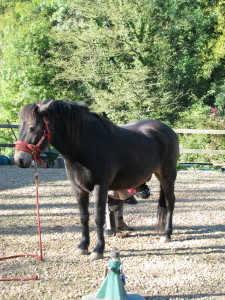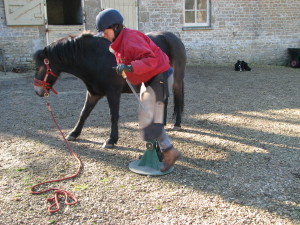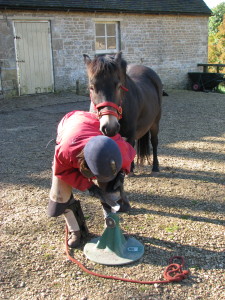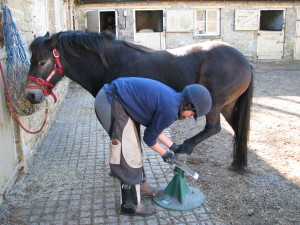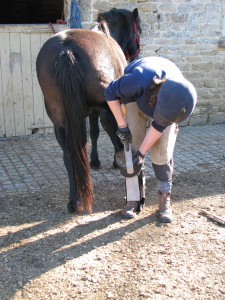Dear Mouse had so many issues, however, that “quickly” isn’t really a word you would associate with his learning. Although intelligent, he sometimes gave the impression that he would rather be left alone, and he needed a lot of consolidation and above all, consistency. He was extremely lucky to find such a patient, dedicated, and committed owner. Lots of people would have given up on him long ago.
Mouse came to Moor Wood for a few days to have, amongst other things, his feet worked on. He had plenty of issues, so there was a lot to choose from, but his feet were obviously a high priority.
I usually prefer to work without someone holding the horse, as I can then just concentrate on the job at hand, and there’s no issue of communication between the two trainers, which can also be confusing to the horse, but it’s not a hard and fast rule. Mouse, like a lot of horses, also didn’t like having more than one person working with him at a time, so we did address that as well, sometimes working together, and sometimes just me on my own, with Steve, Mouse’s owner, taking the photos.
Here you can see a very uncertain pony, free to move if he feels the need to, just about coping with me picking out his hind foot.
Mouse moves away, to give himself a break. In a case like this, there are no negative consequences for moving away, we just bring him back to where we want him to be, noting to ourselves that we needed to stop a bit sooner. Scrabble, our border collies, is in the background, ready to administer a stronger reprimand if necessary.
Putting the hoof on the stand is quite difficult for the horse, for a variety of reasons. Tightness in the shoulder can make it difficult to bring the leg forward. Having the hoof stand at the correct height is essential, and can take some practise. It’s important not to try to keep the leg up for too long, as well, and to not hold on “just to finish this tiny bit of flare.” Giving the horse plenty of breaks during the training process, and putting the foot down on the floor yourself will pay dividends later on.
Hind feet are sometimes easier for the horse than front feet, as it is easier for them to balance. They are usually more worrying for the human, however, as it is easier for them to kick. Hence the helmet – Mouse wasn’t above the odd nip, either!
A haynet can really help occupy the horse throughout a process that can be quite tedious for them, particularly if care is taken to trim and balance the hoof correctly!
Although Mouse is coping well with this, you can see that he isn’t brilliantly balanced, and would be a lot happier if his pelvis were more level. A hoof cradle can help with this, or the trimmer has to be prepared to get down a bit lower. Not that easy with an Exmoor pony, though, and even harder with the smaller breeds.

